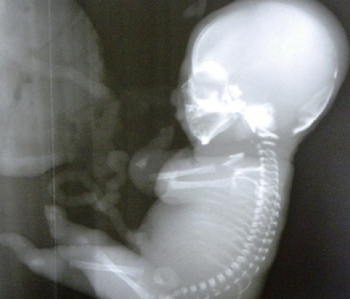Acheiropodia
| Acheiropodia | |
|---|---|
| Other names: Horn-Kolb syndrome, acheiropody and aleijadinhos (Brazilian type) | |
 | |
| Acheiropodia has an autosomal recessive pattern of inheritance | |
Acheiropodia (ACHP) is an autosomal-recessive[1] disorder that results in hemimelia, a lack of formation of the distal extremities.
This is a congenital defect that consists of bilateral amputations of the distal upper and lower extremities, as well as aplasia of the hands and feet. It was first discovered and is prevalent almost exclusively in Brazil.[2]
Signs and symptoms
The clinical presentation of this condition is as follows:[3]
Genetics
ACHP has been associated with a mutation in the LMBR1 gene.[4] The disorder is inherited in an autosomal-recessive manner.[1] This means the defective gene responsible for the disorder is located on an autosome, and two copies of the defective gene (one inherited from each parent) are required to be born with the disorder. The parents of an individual with an autosomal recessive disorder both carry one copy of the defective gene, but usually do not experience any signs or symptoms of the disorder.[citation needed]
Diagnosis

The diagnosis of this condition can be done via the following:[3]
- Medical exam
- Lab test
- Medical history
- Genetic test
Prevalence
In the country known to have the majority of individuals with this condition, Brazil has a frquency of 1 in 250,000 births with Acheiropodia[5]
References
- ↑ 1.0 1.1 Escamilla, Ma; Demille, Mc; Benavides, E; Roche, E; Almasy, L; Pittman, S; Hauser, J; Lew, Df; Freimer, Nb; Whittle, Mr (June 2000). "A minimalist approach to gene mapping: locating the gene for acheiropodia, by homozygosity analysis". American Journal of Human Genetics. 66 (6): 1995–2000. doi:10.1086/302921. PMC 1378047. PMID 10780921.
- ↑ Freire-Maia, A; Opitz, John M. (1981). "Historical note: the extraordinary handless and footless families of Brazil - 50 years of acheiropodia". American Journal of Medical Genetics. 9 (1): 31–41. doi:10.1002/ajmg.1320090108. PMID 7018242.
- ↑ 3.0 3.1 "Acheiropody | Genetic and Rare Diseases Information Center (GARD) – an NCATS Program". rarediseases.info.nih.gov. Archived from the original on 16 April 2021. Retrieved 16 December 2021.
- ↑ Ianakiev P, van Baren MJ, Daly MJ, et al. (January 2001). "Acheiropodia is caused by a genomic deletion in C7orf2, the human orthologue of the Lmbr1 gene". Am. J. Hum. Genet. 68 (1): 38–45. doi:10.1086/316955. PMC 1234933. PMID 11090342.
- ↑ "OMIM Entry - # 200500 - ACHEIROPODY; ACHP". omim.org. Archived from the original on 30 April 2017. Retrieved 16 December 2021.
External links
- Overview Archived 2016-03-03 at the Wayback Machine at Orphanet
- PDF of Am. J. of Human Genetics article
| Classification |
|---|